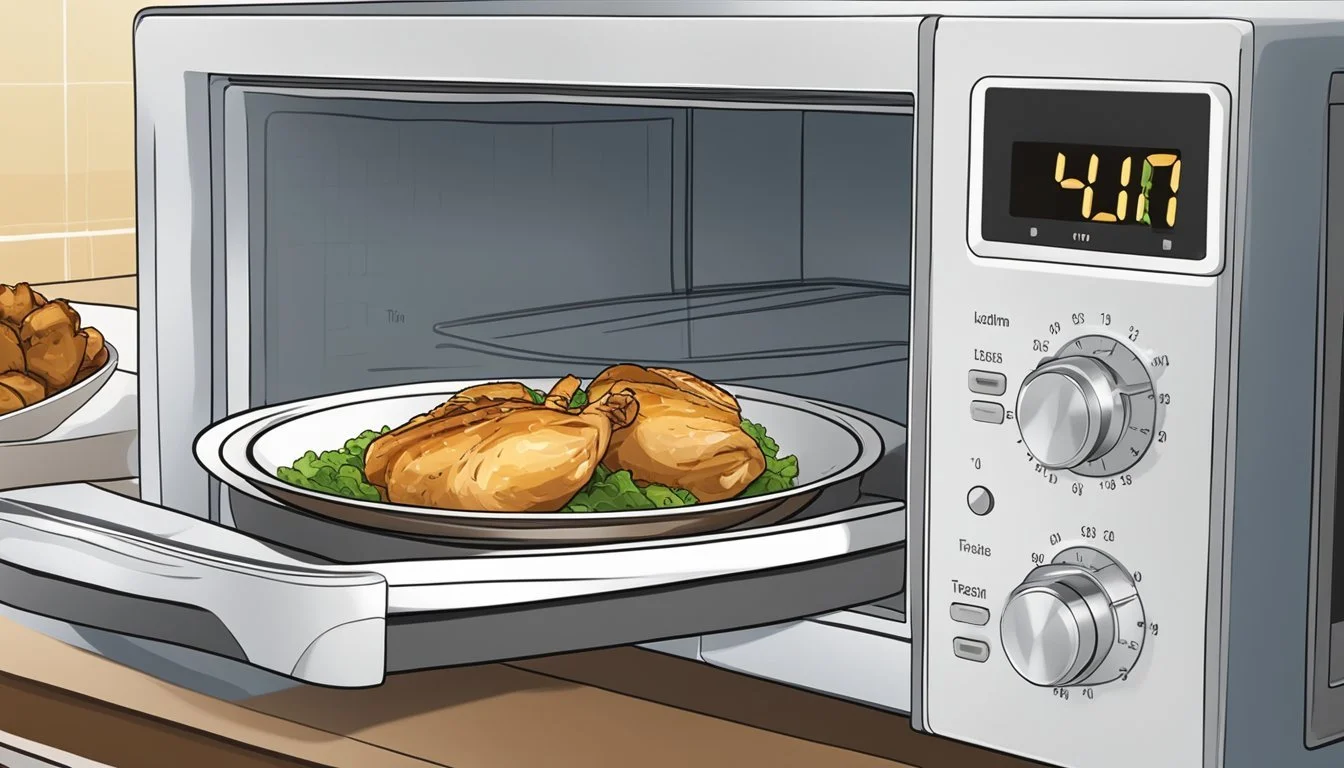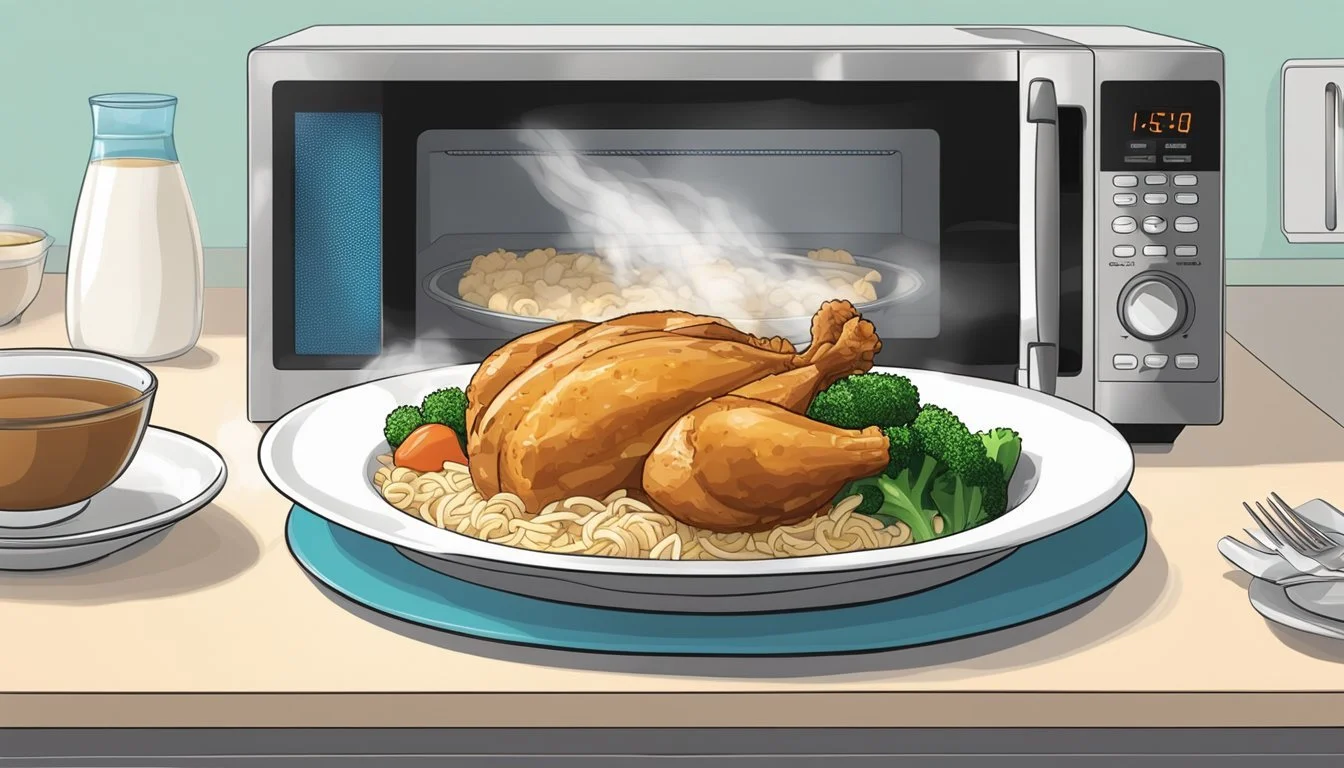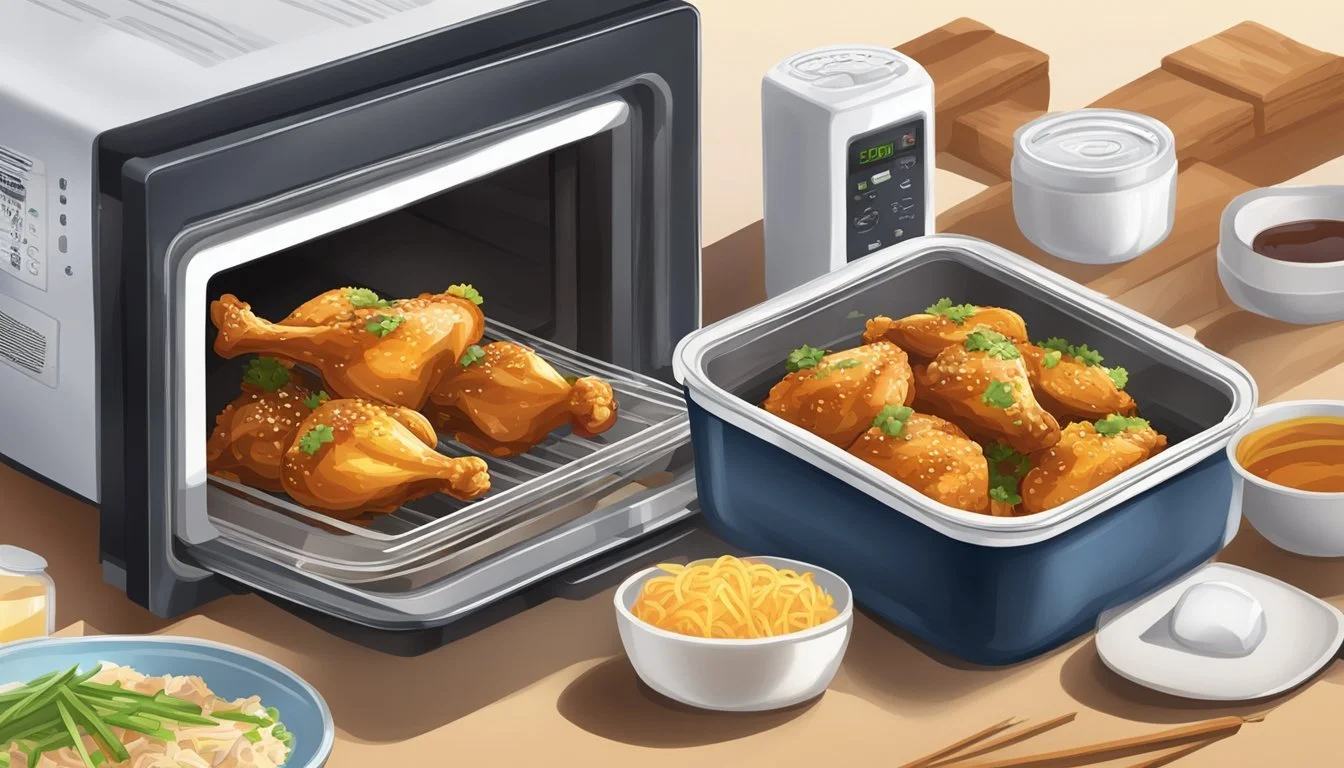How to Reheat Chicken Teriyaki
Expert Tips for Perfect Results
Reheating chicken teriyaki can be a tricky task, but with the right techniques, you can enjoy your leftovers without sacrificing their delicious flavor and tender texture. The best way to reheat chicken teriyaki is to use gentle reheating methods that prevent the chicken from drying out or becoming rubbery. Whether you use a microwave, oven, or stovetop, it’s essential to maintain the dish's moisture and heat it evenly.
One effective method is to reheat your chicken teriyaki in a microwave-safe dish, covered loosely with a damp paper towel. This approach helps retain the moisture, making the chicken succulent and the sauce flavorful. Alternatively, for an even heat distribution, you can reheat it in an oven at a low temperature, covered with foil to avoid losing moisture.
For those who prefer stovetop reheating, placing the chicken teriyaki in a skillet over low heat with a splash of water or extra teriyaki sauce can do wonders. This method ensures the chicken does not overcook and retains its juiciness. By choosing the right reheating technique, you can savor the delightful taste of chicken teriyaki just as much as the first time.
Understanding Chicken Teriyaki Reheating
Reheating chicken teriyaki requires both attention to food safety and proper techniques to ensure the dish remains delicious. Focusing on these areas will help maintain its flavor and texture.
Importance of Proper Reheating
Properly reheating chicken teriyaki ensures the dish retains its flavor and texture. Various methods like microwaving, air frying, and pan-frying can be employed depending on the tools available and personal preference. Microwaving should be done on medium power to avoid drying out the chicken.
Using an air fryer can result in a crispy exterior, while pan-frying allows for control over the heating process by flipping the chicken. Consistently aiming for an internal temperature of 165°F (74°C) guarantees the chicken is heated evenly.
Food Safety Considerations
Food safety is crucial when reheating chicken teriyaki. Bacteria can thrive if the dish is not heated to the proper internal temperature. Always use a food thermometer to check the temperature. Ensure the chicken reaches 165°F (74°C) to eliminate any harmful bacteria.
Avoid reheating chicken multiple times, as this increases the risk of bacterial growth. When using a microwave, cover the dish to retain moisture and encourage even heating. For oven reheating, cover the chicken with foil to prevent it from drying out, ensuring a safe and tasty meal.
Preparation Before Reheating
Properly preparing chicken teriyaki before reheating is essential to achieve the best taste and texture. Key steps include thawing frozen chicken and allowing it to rest at room temperature.
Thawing Frozen Chicken Teriyaki
Start by removing the chicken teriyaki from the freezer. Place it in the refrigerator. This slow thawing method usually takes about 24 hours but ensures the chicken remains within a safe temperature range, reducing the risk of bacteria growth.
If pressed for time, use a quicker method. Seal the chicken in a leak-proof plastic bag. Submerge the bag in cold water. Change the water every 30 minutes to maintain a consistent cold temperature. This method typically takes about 1-3 hours, depending on the size of the chicken pieces.
Avoid thawing chicken teriyaki at room temperature. This can lead to uneven thawing and increases the risk of harmful bacteria growth. The microwave can also be used, but it may partially cook the chicken, leading to less desirable texture upon reheating.
Room Temperature Resting
Once the chicken teriyaki is thawed, let it rest at room temperature for a short while before reheating. Aim for about 15-20 minutes. This practice allows the chicken to warm slightly, ensuring it heats more evenly.
Place the chicken on a clean plate or dish. To avoid contamination, cover the chicken loosely with plastic wrap or a cloth. This prevents dust or other particles from settling on the food.
Observe food safety guidelines. Do not leave chicken teriyaki at room temperature for longer than the recommended time. Any extended period can cause the chicken to enter the danger zone, where bacteria multiply rapidly.
Reheating Methods Overview
Reheating chicken teriyaki can be done in several ways, each having its unique advantages. The choice of method can affect the texture, flavor, and convenience of your reheated meal.
Microwave Method
The microwave is a quick and easy option for reheating chicken teriyaki. To start, place the chicken teriyaki on a microwave-safe plate.
Set the microwave to medium power. Heat for 1-2 minutes per piece of chicken, rotating and flipping halfway through to ensure even heat distribution.
Using a food thermometer, check that the internal temperature reaches 165°F (74°C). This method is best for those in a hurry but can sometimes lead to uneven heating and a slightly rubbery texture.
Oven Method
Using an oven provides consistent heat and helps maintain the chicken's moisture. Preheat the oven to 350°F (175°C). Place the chicken in an oven-safe dish and cover it with aluminum foil to retain moisture.
Heat until the internal temperature reaches 165°F (74°C), which typically takes about 20-25 minutes. This method is ideal for reheating larger quantities and ensures the chicken remains juicy and flavorful.
For added flavor, baste the chicken with extra teriyaki sauce before covering it.
Stovetop Method
The stovetop method is effective for achieving a slightly crisp exterior while maintaining a tender interior. Heat a non-stick skillet over medium heat and add a small amount of oil.
Place the chicken teriyaki in the skillet and cook for 2-3 minutes per side. To enhance flavor, you can add extra teriyaki sauce to the skillet during the final minute of heating.
This method is excellent for preserving texture and enhancing the dish’s flavor profile.
Air Fryer Method
The air fryer method offers a balance between convenience and texture. Preheat the air fryer to 400°F (200°C). Place the chicken teriyaki in the air fryer basket.
Air fry for 4-5 minutes, shaking the basket occasionally to ensure even cooking. Check that the internal temperature reaches 165°F (74°C). This method results in a crispy exterior while keeping the meat juicy.
It’s perfect for those who want a quick and crispy reheating option.
Reheating Chicken Teriyaki in the Microwave
Reheating chicken teriyaki in the microwave is a convenient way to enjoy leftovers. Key techniques involve using microwave-safe containers and ensuring moisture retention during reheating.
Using Microwave-Safe Containers
It's essential to use microwave-safe containers when reheating chicken teriyaki. This ensures safety and prevents unwanted chemicals from leaching into the food.
A microwave-safe plate or bowl is ideal. Place the chicken teriyaki in the container, and cover it with a microwave-safe lid or plastic wrap. The cover must be microwave-safe to prevent harmful substances from contaminating the food.
Heating in intervals helps maintain the chicken's quality. Microwave on high for 30-second intervals, stirring in between. This ensures the chicken heats evenly and avoids drying out.
Adding Moisture During Microwave Reheating
Maintaining moisture is key to reheating chicken teriyaki without making it dry.
Adding a splash of water or chicken broth before covering helps retain moisture. Alternatively, place a damp paper towel over the chicken. This method keeps the chicken juicy during reheating.
Microwave the chicken for 2-3 minutes, checking regularly to avoid overcooking. An internal temperature of 165°F (74°C) indicates the chicken is properly reheated and safe to eat. Using these methods ensures the chicken teriyaki remains tender and flavorful.
Reheating Chicken Teriyaki in the Oven
Using the oven to reheat chicken teriyaki ensures even heating and helps maintain its flavorful taste and texture. Follow these steps for the best results.
Preheating and Preparation
Begin by preheating the oven to 350°F (175°C). While the oven is warming up, prepare the leftover chicken teriyaki. Arrange the chicken pieces on a baking sheet. For better results, use a wire rack on top of the baking sheet to allow for better air circulation, which promotes more uniform heating.
Line the baking sheet with parchment paper for easier cleanup. Ensure there is some space between the chicken pieces for even heating. This preparation ensures the chicken reheats thoroughly and remains juicy.
Covering for Even Heating
To prevent the chicken from drying out, cover the baking sheet with aluminum foil. This traps steam and keeps the chicken moist during the reheating process. Ensure the foil is sealed tightly around the edges to maintain the moisture effectively.
Place the covered baking sheet in the preheated oven. Allow the chicken to heat for about 15-20 minutes. Check the internal temperature with a food thermometer; it should reach 165°F (74°C). Remove the foil in the last few minutes to slightly crisp the exterior if desired.
By following these steps, the chicken teriyaki will be reheated evenly, making it as flavorful as when it was first cooked.
Reheating Chicken Teriyaki on the Stove
Reheating chicken teriyaki on the stove ensures even cooking and retains its juicy flavor. Below are detailed steps for choosing the right skillet and simmering the chicken with sauce.
Choosing the Right Skillet
Selecting the proper skillet is crucial. A non-stick skillet is recommended to prevent sticking and ensure even cooking.
Add a small amount of olive oil to the skillet to enhance flavor and prevent the chicken from drying out. Heat the skillet over medium heat before adding the chicken. This preheating step is essential for consistent reheating. Keep an eye on the temperature to avoid burning the teriyaki sauce or the chicken.
Simmering with Sauce
Adding teriyaki sauce during reheating helps maintain the dish's moisture and flavor. Pour a small amount of teriyaki sauce into the skillet once the chicken is warm.
Allow the chicken and sauce to simmer together for a minute or two. Stir occasionally to ensure every piece is evenly coated and heated. This approach locks in the flavors and creates a delicious, appetizing meal. Use a lid if needed to keep the steam in and evenly distribute heat.
By following these steps, you will achieve a well-reheated chicken teriyaki dish that tastes fresh and flavorful.
Reheating Chicken Teriyaki in an Air Fryer
Using an air fryer to reheat chicken teriyaki offers a quick and effective method that helps maintain the dish's flavors and juiciness. Ensuring proper setup and arrangement in the basket is key to achieving optimal results.
Setting Up the Air Fryer
Preheat the air fryer to 400°F (200°C) to ensure it reaches the right temperature for reheating chicken teriyaki. This step is crucial as it mimics the environment of an oven but provides a faster and more efficient heating process.
Lightly coat the air fryer basket with cooking spray. This prevents the chicken from sticking and helps maintain its texture. Avoid overloading the basket to ensure the hot air circulates properly, reheating the chicken evenly.
Basket Arrangement for Optimal Texture
Arrange the leftover chicken teriyaki pieces in a single layer within the air fryer basket. Ensuring each piece is spaced out allows for even air circulation.
If reheating a large amount, consider doing it in batches to prevent overcrowding. During the cooking process, which typically lasts 4-5 minutes, shake the basket occasionally. This ensures even heating and helps restore the chicken’s original texture without drying it out.
Additional Reheating Tips
Enhancing the flavor and keeping the chicken teriyaki juicy can make a significant difference. It is crucial to ensure that the chicken reaches a safe internal temperature for quality and safety purposes.
Using Liquids to Enhance Juiciness
Adding a liquid like water, chicken broth, or extra teriyaki sauce helps keep the chicken moist during reheating. Simply add a small splash of the chosen liquid to the skillet or oven dish before reheating.
Using oil when reheating in a skillet also prevents sticking and enhances flavor. A drizzle of oil or a bit of chicken broth provides moisture and keeps the meat from drying out.
Stirring occasionally helps distribute the liquid evenly around the chicken, ensuring even reheating and enhanced juiciness.
Checking for Doneness with a Food Thermometer
A food thermometer is essential for checking the internal temperature to ensure food safety. The key internal temperature for reheated chicken teriyaki should reach 165°F (74°C).
Insert the food thermometer into the thickest part of the chicken to get an accurate reading. Avoid touching bone as it can give a false reading.
Proper temperature checks ensure that reheated chicken is safe to eat and maintains its quality. Regularly checking the internal temp will help avoid undercooking and overcooking, preserving flavor and texture.
Serving Reheated Chicken Teriyaki
When it comes to serving reheated chicken teriyaki, enhancing the dish with the right sides and garnishes can elevate the dining experience. Accompanying the main dish with a flavorful side and a fresh garnish will ensure a balanced and appealing meal.
Complementing with Sides
Pairing reheated chicken teriyaki with complementary sides is essential. Rice is a classic choice, as it absorbs the teriyaki sauce well and provides a neutral base. Sushi rice or jasmine rice are both excellent options.
Vegetables can also enhance the meal. Steamed broccoli, bell peppers, or snap peas not only add color but also contrast textures and flavors. For a more filling option, consider including a small serving of yakisoba or stir-fried noodles.
These sides help balance the savory and sweet notes in the chicken teriyaki, making the dining experience more satisfying.
Adding Fresh Garnishes
Adding fresh garnishes to reheated chicken teriyaki can rejuvenate the dish. Green onions provide a mild crunch and a burst of freshness, while sesame seeds add a slight nutty flavor and visual appeal.
Fresh herbs like cilantro can elevate the dish's aroma and taste. Another garnish to consider is a light drizzle of extra teriyaki sauce or a sprinkle of red pepper flakes for those who enjoy a bit of heat.
The addition of these simple yet effective garnishes not only enhances the flavor but also makes the dish look more appetizing.
Storing Leftovers
Properly storing chicken teriyaki leftovers is essential for maintaining optimal freshness and flavor. This involves knowing how to cool the food correctly and using the right storage methods based on whether you will refrigerate or freeze it.
Proper Cooling and Airtight Containers
After cooking, chicken teriyaki should be cooled quickly to prevent bacterial growth. Allow the dish to cool to room temperature for no longer than two hours.
Once cooled, place the chicken teriyaki in an airtight container. Using airtight containers helps prevent moisture loss and protects the food from absorbing other odors in the fridge. Label the containers with the date to keep track of freshness.
For large batches, consider dividing the dish into smaller portions. This makes reheating easier and ensures that only the amount needed is reheated, reducing the risk of overcooking.
Refrigeration Versus Freezing
Refrigeration is suitable if you plan to consume the leftovers within 3-4 days. Store the airtight containers in the coldest part of the fridge, ideally below 40°F (4°C). This helps maintain the chicken's quality and safety.
Freezing is ideal for longer-term storage. Place the chicken teriyaki in airtight containers or resealable freezer bags, removing as much air as possible to prevent freezer burn. Label with the date and use within 2-3 months for the best quality. To thaw, transfer the container to the refrigerator and allow it to thaw overnight.
Ensuring proper storage practices not only maintains flavor and texture but also ensures food safety.






